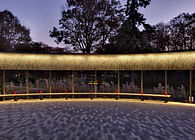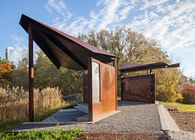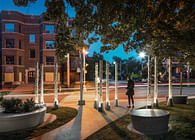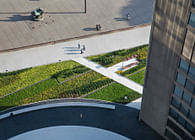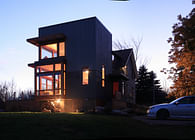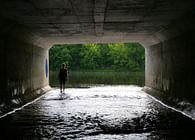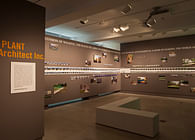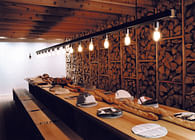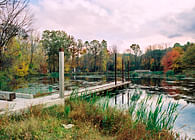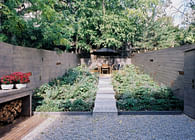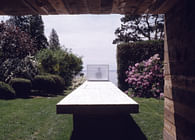
Toronto, ON, CA
The Dublin Grounds of Remembrance in Dublin, Ohio, is a one acre-park honouring the service of veterans and their families. On a site with no prior military significance, the project eschews a traditional “monument” in favour of promoting the act of habitual walking and social gathering, reinforcing community remembrance and creating new significance for the land.
The site, which leads into a deep ravine, is situated on a marginal ravine right-of-way that forms a doughnut around the 1840s village cemetery. Over the past thirty years, Dublin’s nineteenth-century settlement of 750 people ballooned into a golf suburb with 30,000 people, nearly abandoning the historic village and resulting in the newly built library and school turning their backs on the historic cemetery. This new veterans park is key to the City’s programme to revitalize the heritage settlement.
The project was designed to create a formal place for public gathering, with spaces for intimate contemplation. The copper Loggia, with its panoramic window, shelter, and bronze poem wall laser-cut with two stanzas of Emerson’s Concord Hymn, stands as a formal ceremonial backdrop. It serves as the hub for Veterans and Memorial Day celebrations and as a daily retreat for visitors. The limestone Dedication Seat Wall frames the ceremonial area and supports the flag, providing the dedication for the site: This Walk, This Grove, These Grounds are Dedicated to Veterans who have served in the Army, Navy, Marines, Air Force, and Coast Guard. The new Sycamore Grove frames the cemetery, encourages wandering, provides space for large gathering, and, when mature, will shelter the Loggia’s natural am- phitheatre, serving as a place for personal and collective pause.Running through the newly planted Grove is the Recognition Walk, edged by the bronze Guide Rail. This contemplative route connects the ceremonial area to the Memory Wall in the secluded ravine where visitors can leave messages and hand-written notes in the wall’s bronze niches. The unique shape and texture of the Walk’s handrail invites touching, provides support by “hugging back”, and registers the passage of visitors. The Walk itself has been calibrated to pace the strides of visitors and to mark the boundary of the site, with the textures of limestone screenings and paving navigating individual and collective journeys of remembrance. The sound of crunching underfoot, the wear of the path, and the feel of the Guide Rail all reinforce the physical, emotional, and mental reminiscence that generates personal meaning for the site.
Together, these architectural and landscape elements reveal and engage the cultural and natural history of the site by creating and framing a unique dialogue of textures: bronze that polishes with use, smooth limestone, sycamore bark, and the jagged cemetery wall. The crisp, transparent Loggia, the laser- cut lettering of Emerson’s Concord Hymn, and the perforated Memory Wall collectively frame the rugged landscape of the ravine at both large and minute scales. Areas of pause like the copper Loggia and the Memory Wall also punctuate the deeply personal journeys of the site’s visitors.
For this project, walking acknowledges time as a mediator of experience—both for moments of private reflection and during public ritual performance. This profound act of walking permeates the lives of soldiers, veterans, and civilians through its calculated references to marching, pacing, pausing, wandering, and hiking, as well as to parades, processions, and pilgrimages. These physical, public, and participatory acts serve to restore, mobilize, and engage, allowing visitors to commemorate veterans and to connect with the land in restorative and therapeutic ways.
Status: Built
Location: Dublin, OH, US
Firm Role: Architect | Landscape Architect





